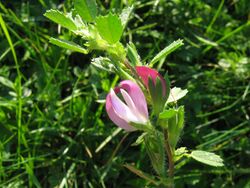Biology:Ononis repens
| Ononis repens | |
|---|---|

| |
| Scientific classification | |
| Kingdom: | Plantae |
| Clade: | Tracheophytes |
| Clade: | Angiosperms |
| Clade: | Eudicots |
| Clade: | Rosids |
| Order: | Fabales |
| Family: | Fabaceae |
| Subfamily: | Faboideae |
| Genus: | Ononis |
| Species: | O. repens
|
| Binomial name | |
| Ononis repens | |
| Wikimedia Commons has media related to Ononis repens. |
Ononis repens or common restharrow is a plant species of the genus Ononis.
Description
It is a prostrate (maximum height 60cm) woody perennial, spreading by rhizomes.[1] It has hairy stems and small oval leaves with toothed edges. Leaflets are less than 3 times as long as wide. It occasionally has soft, weak spines, but never hard spines like those of Ononis spinosa.[2] The leaves are covered in glandular hairs which give a resinous smell on bruising. Plants are hermaphroditic.[3] The zygomorphic flowers are pink and unscented, 15–20mm, blooming from June to September.[4]
Habitat and distribution
It is found by the sea shore, on cliffs and dunes and is also common in grasslands and dry hill pastures in chalk or limestone areas, over light, well-drained soils. It may occasionally grow on roadside verges or beside railways.[5][6][7]
The species is native to Europe including the UK and Ireland. Its distribution spreads as far south as Morocco and as far east as Poland . It has declined in some parts of Britain but populations are generally stable. Although the species is very widespread, its distribution is often localised, due to its preference for particular soil conditions[8][9]
Ecology
A rare species of moth, Aplasta ononaria is specialised to lay its eggs only on common restharrow.[10]
Ononis repens is pollinated by bees.[11][12]
Like other species in the order Fabales, Ononis repens fixes nitrogen into soil from the air, promoting the growth of other plants.[13]
Culinary use
Ononis repens is related to liquorice and its roots have a very similar flavour. A liquorice flavour drink can be made by soaking the roots in cold water, and historically the young shoots have been used as a vegetable, boiled or in salads.[14]
Etymology
The English common name 'restharrow' comes from the plant's propensity to stop horse-drawn farming implements, with its hard, woody roots.[15] The word 'ononis' or 'anonis' has been used for restharrow since classical Greece and Rome and has been suggested to stem from the Ancient Greek onos for donkey because it was used to feed donkeys.[16][17] The species epithet repens is Latin for creeping, referring to the growth habit of the plant.
References
- ↑ Online Atlas of the British and Irish Flora - Ononis repens
- ↑ Nature Spot - Ononis repens
- ↑ Plants for a Future - Ononis repens
- ↑ Nature Spot - Ononis repens
- ↑ Online Atlas of the British and Irish Flora - Ononis repens
- ↑ Nature Spot - Ononis repens
- ↑ First Nature - Ononis repens
- ↑ Online Atlas of the British and Irish Flora - Ononis repens
- ↑ Nature Spot - Ononis repens
- ↑ Butterfly Conservation - Rest Harrow Butterfly
- ↑ Plants for a Future - Ononis repens
- ↑ Bees, Wasps and Ants Recording Society - Melitta tricincta
- ↑ Plants for a Future - Ononis repens
- ↑ Plants for a Future - Ononis repens
- ↑ Northumberland Wildlife Trust - Common Restharrow
- ↑ Wellcome Collection - Ononis repens
- ↑ https://books.google.co.uk/books?id=kaN-hLL-3qEC&pg=PA1877&lpg=PA1877&dq=ononis+latin&source=bl&ots=55dqLYgR6s&sig=ACfU3U1pW9IZtk_krLsZsr6--OpOG1EX9Q&hl=en&sa=X&ved=2ahUKEwify-Cw5IbjAhX6SRUIHXLSC9c4ChDoATABegQICRAB#v=onepage&q=ononis%20latin&f=false CRC World Dictionary of Plant Names]
Wikidata ☰ Q161749 entry



